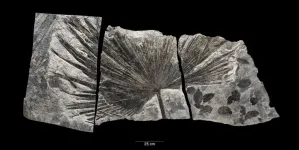(Press-News.org) Jeffrey Elam, senior chemist, Distinguished Fellow, and founder of the atomic layer deposition (ALD) research program at the U.S. Department of Energy’s Argonne National Laboratory, was named as a fellow of the Electrochemical Society (ECS), which focuses on advancing theory and practice at the forefront of electrochemical and solid-state science and technology. Elam, who has been with the lab since 2002, has been a trailblazer in thin film coating science and technology for over 20 years, with contributions including more than 300 scientific publications and 50 U.S. patents that have earned numerous prestigious awards.
When Elam arrived at Argonne in 2002, he brought with him a wealth of knowledge and experience gained through his postdoctoral research at the University of Colorado in a relatively new technology for synthesizing thin film coatings, ALD.
“When I came to Argonne it was a new field,” he said. “Not many people were working in this area, but it had lots of potential because these ultra-thin film coatings can be used to enhance or improve a broad range of devices. For instance, coatings with a thickness of only a few atoms can improve the performance and lifetime of lithium batteries, prevent fouling of polymer membranes used in water treatment, or increase the efficiency of low-cost solar cells.”
In the years since Elam started at Argonne, he has seen the field grow with more scientists and engineers using ALD in their research and ALD coatings being integrated into a wide variety of commercial products. ALD is playing a critical and growing role in microelectronics manufacturing and is being utilized in many steps of the chip making process. Elam is currently working on the ALD of 2D materials that will enable ultra-low power microelectronics.
“When I came to Argonne […] not many people were working in this area, but it had lots of potential because these ultra-thin film coatings can be used to enhance or improve a broad range of devices.” — Jeff Elam, Argonne National Laboratory
Elam has not only advanced his expertise in ALD but also earned five R&D 100 Awards. Known as the “Oscars of Innovation,” these prestigious awards recognize 100 pioneering researchers each year for their groundbreaking contributions to science and technology. The awards recognize his development of innovations including durable diamond-based seals, advanced particle detection plates, anti-static coatings for electronics, precise patterning methods for microelectronics and a reusable sponge for oil spill cleanup.
Elam also helped develop the world’s largest microchannel plate (MCP), a solid-state, 2-dimensional electron amplifier critical to a variety of imaging and sensing applications. He used nanocomposite coatings to create a manufacturing strategy for MCPs that drove down cost, improved performance and widened applications. Elam received a B.A. in Chemistry from Cornell University and his Ph.D. in Physical Chemistry from the University of Chicago. His work in the George Lab at UColorado focused on surface science and thin film growth, which set him on the path toward his ongoing research programs in ALD.
Argonne National Laboratory seeks solutions to pressing national problems in science and technology by conducting leading-edge basic and applied research in virtually every scientific discipline. Argonne is managed by UChicago Argonne, LLC for the U.S. Department of Energy’s Office of Science.
The U.S. Department of Energy’s Office of Science is the single largest supporter of basic research in the physical sciences in the United States and is working to address some of the most pressing challenges of our time. For more information, visit https://energy.gov/science.
END
Elam named as a Fellow of the Electrochemical Society
Elam’s contributions to thin film coating science and technology have advanced the field as it develops into a major factor in modern materials science
2024-09-19
ELSE PRESS RELEASES FROM THIS DATE:
Study reveals gaps in access to long-term contraceptive supplies
2024-09-19
Oregon Health & Science University researchers have found that despite legislation in 19 states requiring insurers to cover a 12-month supply of contraception, patients aren’t receiving a year’s worth of their prescription; most receive just three months or less.
Their study recently published in the journal JAMA Health Forum shows that policies requiring coverage of a 12-month supply of short-acting hormonal contraception — most commonly the birth control pill — have not been fully implemented, resulting in no substantial increases nationally in year-long prescription orders. This leaves many patients at an increased risk for unintended ...
Shining a light on the roots of plant “intelligence”
2024-09-19
All living organisms emit a low level of light radiation, but the origin and function of these 'biophotons' are not yet fully understood. An international team of physicists, funded by the Foundational Questions Institute, FQxI, has proposed a new approach for investigating this phenomenon based on statistical analyses of this emission. Their aim is to test whether biophotons can play a role in the transport of information within and between living organisms, and whether monitoring biophotons could contribute to the development of medical techniques for the early diagnosis of various diseases. Their analyses of the measurements of the faint glow emitted by lentil ...
Scientists identify a unique combination of bacterial strains that could treat antibiotic-resistant gut infections
2024-09-19
Antibiotic-resistant bacterial infections often occur in patients with chronic inflammatory intestinal conditions, such as inflammatory bowel disease, and in patients who have taken antibiotics for a long time. Gram-negative bacteria such as Enterobacteriaceae are a common cause of these infections and have few treatment options. Fecal microbiota transplants have shown promise to curb some of these infections, but their composition varies between batches and they aren’t always successful.
Researchers at Keio University School of Medicine in Tokyo and the Broad Institute of MIT and Harvard have isolated ...
Pushing kidney-stone fragments reduces stones’ recurrence
2024-09-19
Sometimes all it takes is a little push.
That is the conclusion of a recently published study in which doctors used a handheld ultrasound device to nudge patients’ kidney-stone fragments.
As many as 50% of patients who have kidney stones removed surgically still have small fragments remaining in the kidneys afterward. Of those patients, about 25% find themselves returning for another operation within five years to remove the now-larger fragments.
UW Medicine researchers found, however, that patients ...
Sweet success: genomic insights into the wax apple's flavor and fertility
2024-09-19
A recent study has successfully decoded the autotetraploid genome of the wax apple, uncovering its genetic evolution and key factors driving fruit diversity. The research highlights the fruit’s rich antioxidant profile, with promising implications for human health and breeding strategies aimed at enhancing nutritional value.
Wax apple (Syzygium samarangense), known for its crisp texture, rose-like aroma, and health benefits, faces breeding challenges due to its complex genetic diversity and limited genomic data. These obstacles have hindered efforts to improve key fruit qualities such as size and sugar ...
New study charts how Earth’s global temperature has drastically changed over the past 485 million years, driven by carbon dioxide
2024-09-19
A new study co-led by the Smithsonian and the University of Arizona offers the most detailed glimpse yet of how Earth’s surface temperature has changed over the past 485 million years. In a paper published today, Sept. 19, in the journal Science, a team of researchers, including paleobiologists Scott Wing and Brian Huber from the Smithsonian’s National Museum of Natural History, produce a curve of global mean surface temperature (GMST) across deep time—the Earth’s ancient past stretching over many millions of years. ...
Scientists say we have enough evidence to agree global action on microplastics
2024-09-19
Science has provided more than sufficient evidence to inform a collective and global approach to tackle the continued spread of plastic pollution, according to a new report.
Writing in the journal Science, an international group of experts say the need for worldwide action to tackle all forms of plastic and microplastic debris has never been more pressing.
It is clear that existing national legislation alone is insufficient to address the challenge, they say, and the United Nations’ Plastic Pollution Treaty ...
485 million-year temperature record of Earth reveals Phanerozoic climate variability
2024-09-19
Estimating past global temperature is important for understanding the history of life on Earth and for predicting future climate. Now, a new reconstruction of Earth’s temperature history over the past 485 million years – based on a method that combines diverse physical proxy data with climate model predictions – reveals a much wider range of climate variability across the Phanerozoic eon than previously understood. The findings highlight atmospheric carbon dioxide (CO2) as the dominant factor controlling climate variability throughout this period, offering new ...
Atmospheric blocking slows ocean-driven glacier melt in Greenland
2024-09-19
Cooling in the subsurface waters beneath Greenland’s Nioghalvfjerdsfjorden Glacier (79NG) from 2018 to 2021 was driven by European atmospheric blocking, which forced changes in the large-scale ocean circulation of the Nordic seas, researchers report, slowing glacial melt, despite ongoing global warming trends. The findings highlight the importance of regional atmospheric dynamics in influencing glacier stability. Understanding these dynamics is key to predicting the future of glaciers like ...
Study: Over nearly half a billion years, Earth’s global temperature has changed drastically, driven by carbon dioxide
2024-09-19
Published in the journal Science, the study presents a curve of global mean surface temperature that reveals Earth's temperature has varied more than previously thought over much of the Phanerozoic Eon a period of geologic time when life diversified, populated land and endured multiple mass extinctions. The curve also confirms Earth's temperature is strongly correlated to the amount of carbon dioxide in the atmosphere.
The start of the Phanerozoic Eon 540 million years ago is marked by the Cambrian ...
LAST 30 PRESS RELEASES:
Norbert Holtkamp appointed director of Fermi National Accelerator Laboratory
New agentic AI platform accelerates advanced optics design
Biologists discover neurons use physical signals — not electricity — to stabilize communication
Researchers discover that a hormone can access the brain by hitchhiking
University of Oklahoma researcher awarded funding to pursue AI-powered material design
Exploring how the visual system recovers following injury
Support for parents with infants at pediatric check-ups leads to better reading and math skills in elementary school
Kids’ behavioral health is a growing share of family health costs
Day & night: Cancer disrupts the brain’s natural rhythm
COVID-19 vaccination significantly reduces risk to pregnant women and baby
The role of vaccination in maternal and perinatal outcomes associated with COVID-19 in pregnancy
Mayo Clinic smartwatch system helps parents shorten and defuse children's severe tantrums early
Behavioral health spending spikes to 40% of all children’s health expenditures, nearly doubling in a decade
Digital cognitive behavioral treatment for generalized anxiety disorder
Expenditures for pediatric behavioral health care over time and estimated family financial burden
Air conditioning in nursing homes and mortality during extreme heat
The Alps to lose a record number of glaciers in the next decade
What makes a good proton conductor?
New science reporting guide published for journalists in Bulgaria
New international study reveals major survival gaps among children with cancer
New science reporting guide published for journalists in Turkey
Scientists develop a smarter mRNA therapy that knows which cells to target
Neuroanatomy-informed brain–machine hybrid intelligence for robust acoustic target detection
Eight SwRI hydrogen projects funded by ENERGYWERX
The Lundquist Institute and its start-up company Vitalex Biosciences Announces Strategic Advancement of Second-Generation fungal Vaccine VXV-01 through Phase 1 Trials under $40 Million Competitive Con
Fine particles in pollution are associated with early signs of autoimmune disease
Review article | Towards a Global Ground-Based Earth Observatory (GGBEO): Leveraging existing systems and networks
Penn and UMich create world’s smallest programmable, autonomous robots
Cleveland researchers launch first major study to address ‘hidden performance killer’ in athletes
To connect across politics, try saying what you oppose
[Press-News.org] Elam named as a Fellow of the Electrochemical SocietyElam’s contributions to thin film coating science and technology have advanced the field as it develops into a major factor in modern materials science



